#glycyrrhizae
Text

ok em....Glabra before....everything....and I'm not going to spoil how the hell did he still alive
#cookie run#cookie run kingdom#cookie run oc#cookierun#cookie run au#witch's watcher au#witch watcher au#mystic flour cookie#glycyrrhiza glabra cookie#licorice herp cookie
12 notes
·
View notes
Text
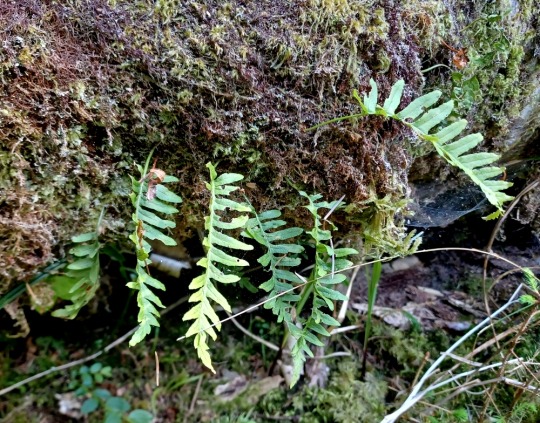
A friend came to visit for a couple of days, so we did a big hike all over the South Bay (Tarlatt/Riekkola) Unit of Willapa NWR. I didn't get a ton of pictures, but I did snap this one of licorice ferns (Polypodium glycyrrhiza) on a mossy nurse log. It's named for the sweet, licorice-like flavor of the edible rhizome.
It's not something I've personally tried. I'm not a fan of the licorice flavor to begin with, but more importantly as a forager I tend to avoid harvesting anything that would require me to kill the entire plant. Leaves, flowers, berries, sure--I'm okay with that. And no, pulling up a mushroom will not kill the entire fungus.
I think it's important to be able to recognize edible plants and fungi and know how to prepare them, both for curiosity's sake and also because there's always that chance of getting lost in the woods while hiking and needing to find emergency food. But I am not one of these super hardcore western foragers where 95% of what they eat normally is foraged, fished, or hunted. I don't have the time, quite honestly, and there are ways to eat relatively sustainably that can include more conventional foods.
Moreover, a lot of the things we like to forage are food for wildlife (who can't just go to a grocery store), or carry seeds or spores that are needed to replenish the local population of a given species. I don't think foragers talk nearly enough about the impact we can have on ecosystems when we over-harvest, especially as foraging becomes more popular. I already teach my foraging students to not take more than 25% of something from a given area, which is a lot stricter than many other foragers' guidelines. For myself, I'll sometimes incorporate something I've brought home like mushrooms or berries into my cooking, especially if it's something new to me that I want to get a better sense of. But it's more as seasonal treats that I look forward to throughout the year, not as the core of my food security.
And for something like licorice fern, my personal view is "Just because you can, doesn't mean you should." It's not an endangered species, but it's not necessary for me to collect something that will cause me to rip up an entire plant while also disturbing well-developed moss forests to get at the rhizome. So I'll let the ferns keep on living, and go harvest some literal low-hanging fruit once the salmonberries get their last bit of ripening in.
#licorice fern#Polypodium glycyrrhiza#wild foods#foraging#forager#PNW#Pacific Northwest#ferns#plants#botany#food#nature#Willapa NWR#Willapa National Wildlife Refuge#Washington
12 notes
·
View notes
Text

2 notes
·
View notes
Text


16 notes
·
View notes
Photo
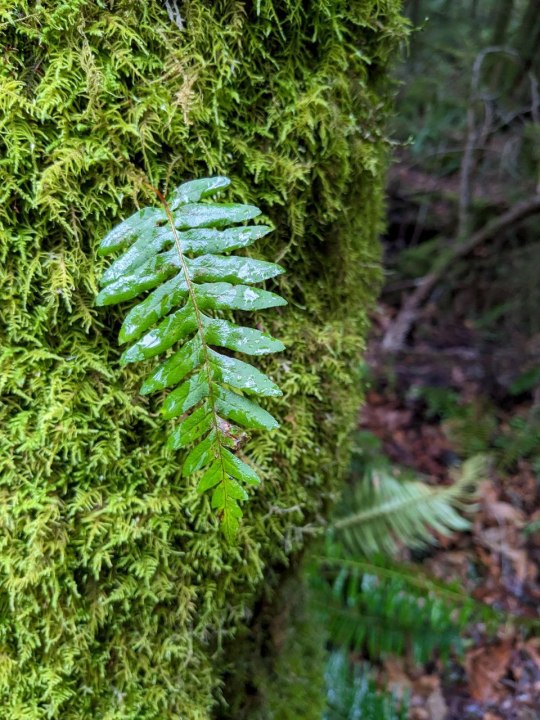
Polypodium glycyrrhiza or licorice fern. In the PNW any fern growing from a tree like this is most likely Polypodium glycyrrhiza
5 notes
·
View notes
Text

#💥NÁM DA KHÔNG ĐÁNG LO#VÌ ĐÃ CÓ MUNTIFUNTION SKIN CREAM 💥#Một sản phẩm cực kỳ chiều lòng khách hàng đang bị nám#khách hàng không còn lo lắng vì những “chị nám đáng ghét”. Giờ đây Muntifuntion Skin Cream (kem ngày) đã có thể giải quyết triệt để cho khá#Sản phẩm với chiết xuất lô hội (Aloe Vera Gel)#chiết xuất Cúc La Mã (chamomile glycolic) giúp nuôi dưỡng làn da#cấp ẩm#bù nước mạnh mẽ#giúp da luôn tươi sáng khỏe mạnh. Đặc biệt#với chiết xuất của Rễ Cam Thảo (Glycyrrhiza Glabm) và Alpha Arbutin kết hợp với Niacinamide (Vitamin B3) là bộ 3 hoạt chất làm sáng da#mờ nám hiệu quả bậc nhất hiện nay sẽ giúp cho làn da của bạn trở nên khỏe mạnh#trắng sáng#mờ nám#mờ thâm hiệu quả nhất.#---------------------------------------------------#🎁D.O COSMETIC 🎁#📌 Địa chỉ: 75 Dương Khuê#Mỹ Đình 2#Nam Từ Liêm#Hà Nội#📞 Hotline: 0971.186.868#🌐 Website: https://myphamdo.com/
2 notes
·
View notes
Text

Herbal Products are the best, they have no side effects on users body or health. They work like magic, whether it is medicine, extracts or Vegetable Powders, each of them shows positive results in the long run.
#Tribulus Terrestris Dry Extract#Curcuma longa Dry Extract#Centella asiatica Dry Extract#Terminalia Arjuna Dry Extract#Glycyrrhiza glabra Dry Extract
0 notes
Text

PINMIN 9G Multivitamin and Multiminerals Soft gel Capsules is an excellent product from house of PINAMED DRUGS. It is a nutritional supplement that restores the level of vitamins and minerals in your body and helps to improve your overall health. It helps in fighting fatigue and improving your wellbeing. Ginseng, Garlic, Grape Seed, Green Tea, Ginkgo Biloba, Guggul, Green Coffee Bean, Giloy & Glycyrrhiza Glabra are 9 (G) that Promotes Healthy Aging, Reduces Anxiety and Stress, Boosts Your Cardiovascular Health, Covers Your Nutritional Bases, Supports Your Immune System, Keeps Body in Good Working Order, Improves Your Eyesight, Keeps Your Bones & Joints Strong & Enhances energy levels and Eliminates Impurities and Toxins. One can take this supplement daily and experience overall health benefits with the advise of Health Expert.
#pinamed#pinameddrugs#pinmin#pinmin9g#9G#multivitamins#multiminerals#antioxidant#softgel#SoftgelCapsule#overallhealth#ginseng#garlic#GRAPESEEDEXTRACT#greentea#ginkgobiloba#guggul#greencoffee#giloy#Glycyrrhiza#antiaging#immunesystem#nutraceuticals#ambala#PCDfranchisebusiness#PCDPharmaFranchise#PCD#PCDPharma#PharmaFranchise
#pinamed#pinameddrugs#pinmin#pinmin9g#9G#multivitamins#multiminerals#antioxidant#softgel#SoftgelCapsule#overallhealth#ginseng#garlic#GRAPESEEDEXTRACT#greentea#ginkgobiloba#guggul#greencoffee#giloy#Glycyrrhiza#antiaging#immunesystem#nutraceuticals#ambala#PCDfranchisebusiness#PCDPharmaFranchise#PCD#PCDPharma#PharmaFranchise
1 note
·
View note
Photo

Kim Min-Sang, One Thousand Won Lawyer'
Source: k-star-holic.blogspot.com
1 note
·
View note
Text
Root of the Month for April 2023: Licorice Root

Licorice Root: a staple in domination work; particularly influencing the heart and desires in lust, love, and fidelity.
Taxa (Family/Genus/species): Leguminosae/Glycyrrhiza/glabra or glanduldifera or echinata
Folk Nomenclature: Sweet Root
Common Name: Black Sugar, Licorice, Sweet Wood
Native Locality: North Africa & Eurasia
Phenotypic Traits: Long, smooth, & firm; very stick-like. Greyish-brown in color. Carries a pungent, bitter-sweet taste. Smells sweet & carmelizing
Parts Used: Root
Gender: Cold
Planetary Ruler: Venus
Elemental Ruler: Water
Traditional Usage in Rootwork: Domination works of the lustful, love-drawing, & fidelity nature.
Traditional Medicinal Usage: Used as a flavoring (to mask the taste of medicines), relieves inflammation, clears away mucus (phlegm), alleviate respiratory issues, & soothes gastrointestinal issues

🌟 FINAL copies of The 2023 Hoodoo's Calendar are available for purchase! Subscribe to the official e-newsletter for the latest updates & exclusive content access. https://thehoodoocalendar.square.site 🌟

#licorice root#licorice plant#licorice#herbology#herbalism#roots#rootwork#rootworkers#atr#atrs#hoodoo
100 notes
·
View notes
Text

Fern Friday
Licorice Fern aka Polypodium glycyrrhiza
I use to spend lots of time chewing this fern's root. So Sweet. I'm thinking of adding this fern to my garden this year. Summer dormant and winter green I know it doesn't offer much to the bees but then it doesn't eat them either.
8 notes
·
View notes
Text

This is Glycyrrhiza Glabra Cookie(Glabra Cookie for short)
he's Licorice Cookie's dad, or should I say Licorice Cookie's creator
he makes Licorice Cookie with dark magic(and no one in the village knows about it...)
Bonus:

#cookie run#cookie run oc#cookie run kingdom#licorice cookie#cookie run au#Witch's Watcher AU#glycyrrhiza glabra Cookie#glabra Cookie
17 notes
·
View notes
Text
What Are Lithophytes?

Originally posted on my website at https://rebeccalexa.com/what-are-lithophytes/
Ask most people what plants need to grow in, and they’ll say “soil” or “dirt”, right? And for the majority of terrestrial plants that’s the case. But given the sheer scale of biodiversity and the ability of species to make use of any niche–no matter how small–left unoccupied, there are of course exceptions. Take epiphytes, for example, that cling to the bark of trees and other plants. Rather than drawing nutrients and water from soil, they instead absorb what they need from the air. Psammophytes also get what they need from the air, but instead sink their root system into shifting sand dunes.
I am especially fascinated by lithophytes. “Litho-” means “stone”, and so a lithophyte is simply a plant that grows on stone. There are two main types of lithophyte. Epilithic lithophytes grow on a stone’s surface, and a crevice in the stone may be populated by endolithic lithophytes. Some of these plants can only grow on stone, so they’re described as obligate lithophytes, but their facultative lithophyte neighbors are those that are able to colonize both stone and soil or another substrate at the same time–some lithophytes can even live as tree-dwelling epiphytes instead!
Like epiphytes, a lithophyte may have some ability to absorb water and nutrients from the air. But they also capitalize on anything that ends up washed into their roots by rain. Endoliths may find that over time debris accumulating in their crevice offers a much-needed resource boost. As part or all of a lithophyte dies, the surrounding plants extract nutrients from the decaying matter–nothing goes to waste in nature, after all. They do not, as a general rule, have a negative effect on the rocks themselves; while some rock-dwelling lichens may chemically weather the stone beneath them, lithophytic plants simply use the rock as a convenient surface to take root.
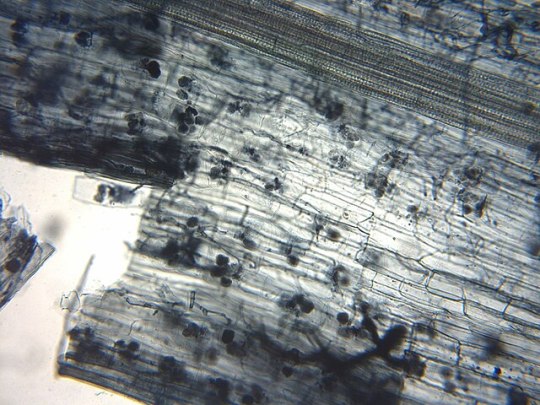
Arbuscular mycorrhizae within a root as seen under a microscope
What I find really cool is that lithophytes can be mycorrhizal! Their roots are pierced by colonies of various arbuscular mycorrhizal fungi that draw up nutrients from the soil and share them with the plants. While this is a very common relationship in nature–four out of every five vascular plant species uses arbuscular mycorrhizal networks–lithophytes seem to have cultivated a greater concentration of these helpful fungi.
A moss-covered rock is often someone’s first encounter with lithophytes. Lacking proper roots, mosses hang onto the stone with tiny rhizomes. Over time they might cover its entire surface, and if said surface is relatively flat and protected from weather and other erosive forces, their decaying remains could be the very beginning of a new patch of soil.
But it’s not just the little bryophytes like mosses that can eke out a living on a rock. More complex vascular plants may also take root on or within stone. One of my favorite ferns, the licorice fern (Polypodium glycyrrhiza) commonly grows as an epiphyte on trees in the Pacific Northwest, but given the right opportunity it will colonize a suitable crevice in a cliff. Orchids may have a reputation for being difficult to care for in captivity, but in the wild there are a lot of lithophytic species. Many, like Dendrobium teretifolium or many Phalaenopsis species, can also live quite well as epiphytes on a tree or other plant. And the wallflower, Erysimum cheiri, got its common name for its tendency to grow out of cracks in rocky slopes.

Nepenthes campanulata
Unsurprisingly, some carnivorous plants make their homes on rocks, and their carnivory allows them access to much-needed nutrients in an otherwise limited setting. The pitcher plant Nepenthes campanulata often grows in colonies on cliff faces. Heliamphora exappendiculata, another pitcher plant, will happily grow both in wetlands and on constantly damp rocks. Sanderson’s bladderwort (Utricularia sandersonii) doesn’t eat insects, but instead sucks up microscopic organisms using bladders the plant buries under nearby soil or sediment.
One more thing: are the plants you see growing in gravel also lithophytes? Not necessarily. There may be soil beneath the gravel that the plant is exploiting. Or the gravel itself may be part of a mineral soil–one that has a lot of stone and not much organic material. A true lithophyte is going to be attached to a rock or rooted in its crevice, though it’s possible to find lithophytes growing on stones that, through weathering, may be feeding fragments into a nearby mineral soil over time.
Did you enjoy this post? Consider taking one of my online foraging and natural history classes or hiring me for a guided nature tour, checking out my other articles, or picking up a paperback or ebook I’ve written! You can even buy me a coffee here!
#lithophytes#botany#plants#science#nature#scicomm#carnivorous plants#moss#fungi#mycorrhizal fungi#mycology#ecology#bryophytes#biodiversity#epiphytes#educational
121 notes
·
View notes
Text

⭐️ new from saie !!
$25.00 USD
12 ml / .4 oz
6 shades at launch
Sephora tags: clean + planet aware, liquid formula, natural finish, vegan, fragrance free, without silicones.
“A lightweight, buildable liquid-cream bronzer that blends seamlessly into skin for a subtly defined bronze with a dewy, soft-focus finish.”
🌙✨ ingredient list (at launch) -
Isocetyl Stearoyl Stearate, Glycerin, Tribehenin, Glyceryl Stearate, Silica, Aqua/Water/Eau, Sambucus Nigra, Fruit Extract, Glycyrrhiza Glabra (Licorice) Root Extract, Morus Alba Leaf Extract, Symphytum Officinale Leaf Extract, Oenothera Biennis (Evening Primrose) Root Extract, Mica, Tin Oxide, Titanium Dioxide (CI 77891), Iron Oxides (CI 77491, CI 77492, CI 77499).
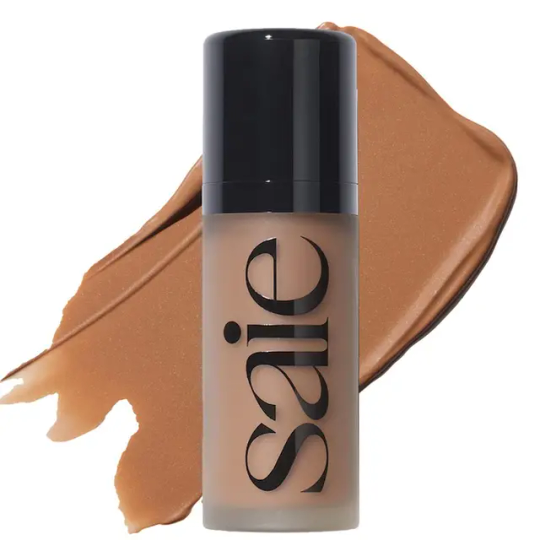


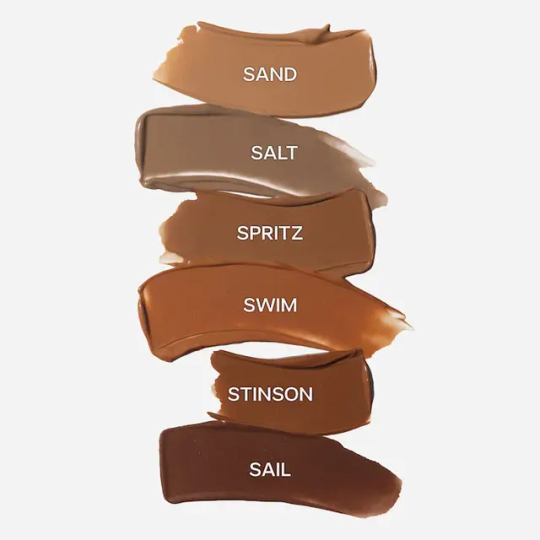

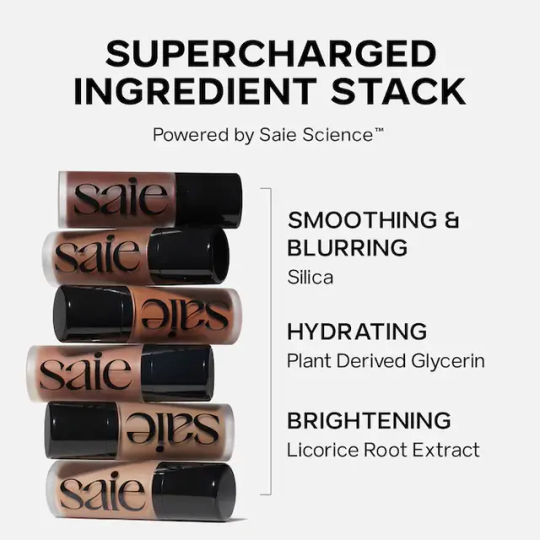


#New makeup#makeup#makeup news#Coquette#dark coquette#Girlblogger#girlblog#this is a girlblog#Beauty#cosmetics#bronzer#Liquid bronzer#🤍 lifestyle tag#📁 filed under makeup#Saie
3 notes
·
View notes
Text
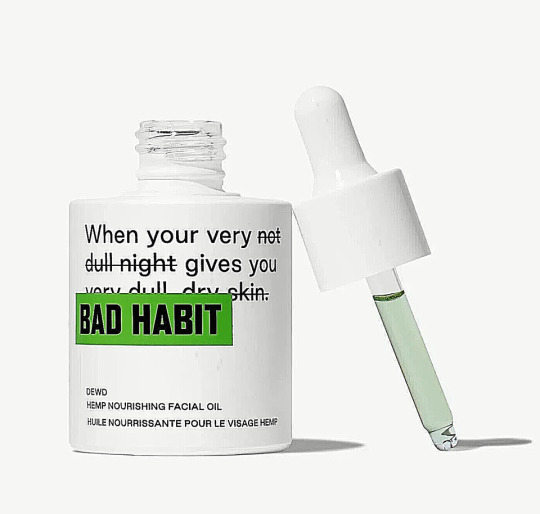


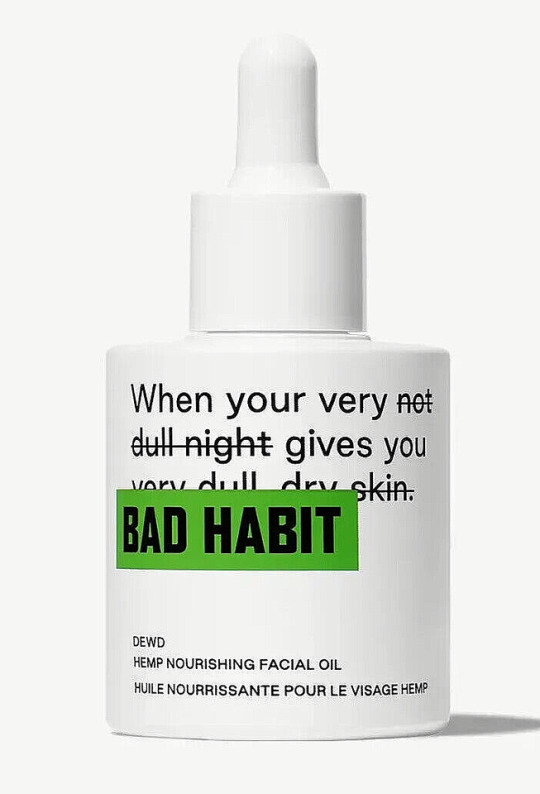


BAD HABIT DEWD HEMP NOURISHING FACIAL OIL 1 OZ MORINGA SATIVA ADAPTOGEN LAVENDER.
This deeply moisturizing oil is infused with ultra-nourishing botanicals for dewy, healthy-looking skin.
Nourishing hemp and moringa seed oil deeply moisturize
Adaptogens help relieve stressed-out skin
Lavender and geranium essential oils soothe your senses*
Deeply moisturize skin with this lightweight, fast-absorbing elixir. Powered by hemp seed oil, this non-greasy formula provides an optimal balance of omega fatty acids to visibly calm, brighten, and nourish stressed-out and irritated skin. Antioxidant-rich moringa seed oil deeply moisturizes to get skin glowing, and a blend of adaptogens—turmeric, licorice, and holy basil—help skin bounce back from environmental stressors. Lavender and geranium essential oils soothe your senses for the ultimate stress relief.
Net Weight: 30 mL / 1 fl. oz.
FREE SHIPPING. VOLUME PRICING. THANK YOU!
Results (FROM THEIR WEBSITE):• 100% showed improvement both immediately and 8 hours after application.†• 100% said their skin looked healthy after using the product.†• 97% said the product absorbed quickly after applying.†† Based on a U.S. consumer perception study of 30 participants 8 hours after application.Diheptyl Succinate, Cannabis Sativa Seed Oil, Helianthus Annuus (Sunflower) Seed Oil, Simmondsia Chinensis (Jojoba) Seed Oil, Squalane, Capryloyl Glycerin/Sebacic Acid Copolymer, Carthamus Tinctorius (Safflower) Seed Oil, Melia Azadirachta Leaf Extract, Melia Azadirachta Flower Extract, Corallina Officinalis Extract, Curcuma Longa (Turmeric) Root Extract, Glycyrrhiza Glabra (Licorice) Root Extract, Coccinia Indica Fruit Extract, Solanum Melongena (Eggplant) Fruit Extract, Curcuma Longa (Turmeric) Leaf Extract, Ocimum Sanctum Leaf Extract, Moringa Oleifera Seed Oil, Tocopheryl Acetate, Caprylyl Glycol, Amber Powder, Fragrance (Parfum), Geraniol, Linalool.*Our functional fragrance contains a blend of natural fragrances and essential oils that includes lavender and geranium. #dawnettsemporium, #beautifulmermaidqueen, #shaunalynnsfood.
2 notes
·
View notes
Text
New species I’m getting this year!
Antennaria rosea (Rosy pussytoes)
Arisaema dracontium (Green dragon)
Asplenium scolopendrium (Hart’s tongue)
Calycanthus floridus (Sweetshrub)
Carex aurea (Golden sedge)
Claytonia virginica (Fairy spuds)
Echinacea pallida (Pale purple coneflower)
Equisetum hyemale (Scouring rush)
Iris setosa (Bristle-pointed iris)
Linnaea borealis (Twinflower)
Lonicera canadensis (Canadian fly honeysuckle)
Lonicera involucrata (Twinberry honeysuckle)
Osmunda claytoniana (Interrupted fern)
Passiflora incarnata (Maypop)
Pediomeleum esculentum/Psoralea esculenta (Breadroot)
Polystichum munitum (Western sword fern)
Triglochin maritma (Seaside arrowgrass)
Vaccinium macrocarpon (Large cranberry)
Viburnum acerifolium (Maple-leaved viburnum)
Viola pedata var. bicolor (Crowfoot violet)
Species I’m trying again this year after failed past attempt(s)!
Antennaria neglecta (Field pussytoes) Was planted in late summer and I was kept from watering it adequately.
Argentina anserina (Silverweed) No idea why they didn’t survive where I put them, but try, try again, elsewhere this time.
Artemisia frigida (Fringed sagebrush) First time ended up being white sage brush instead; second time plug was on its last legs on arrival, died soon after.
Chamaenerion angustifolium (Fireweed) Going to try this in yet another spot.
Dennstaedtia punctiloba (Hay-scented fern) Supposed to be aggressive! Mine was not. Maybe the one I get this year.
Dioscorea villosa (Wild yam) Planted the tuber but it never came up.
Glycyrrhiza lepidota (Wild licorice) Squirrels...Dug it up and broke the stem.
Lupinus polyphyllus (Big-leaf lupine) Leafed out nicely for its first and second year and then just didn’t come up again after its second winter.
Maianthemum racemosum (False Solomon’s seal) Squirrels! Dug it up and broke the stem.
Pteridium aquilinum latiusculum (Western bracken fern) I put it in a dry shady spot, as recommended, and it died.
Rudbeckia hirta (Black-eyed Susan) SQUIRRELS!!! Dug it up and while I was visiting home and it dried out. Couldn’t revive it.
Silene acaulis (Moss campion) Sunny, wet, amongst rocks. Check, check, check, but they keep dying on me.
Sisyrinchium montanum (Blue-eyed grass) Two places tried, two place died. I shall try a third place this year.
Viola pubescens (Downy yellow violet) FUCKING. SQUIRRELS. Dug it up while I was at work and left it to scorch and dry out in the sun. Couldn’t revive it.
Species I’m getting again because I’m fairly sure mine didn’t make it
Apocynum cannabinum (Hemp dogbane) It might not have gotten enough sunlight thanks to the white mulberry that grew over. I’ll try it in a different area.
Sagittaria latifolia (Duck potato) It may come up after all but I don’t want to take the chance of planting too late if it doesn’t.
Sparganium americanum (American bur-reed) Not sure why, but we’ll try again this year. And I may yet be surprised.
Symplocarpus foetidus (Skunk cabbage) It’s possible it’s just young and takes longer to come up than it would if it were more mature, but I don’t want to take chances since there’s only one place I can get them at.
11 notes
·
View notes